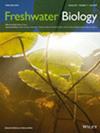水文和营养条件调节大型浅湖藻类生物量对复合热浪和干旱事件的响应
IF 2.7
2区 生物学
Q2 ECOLOGY
引用次数: 0
摘要
复合热浪和干旱(CHWD)事件日益频繁,对水生生态系统构成重大挑战。本研究评估了2022年中国东部平原生态区内40个大型浅湖(50 km2)叶绿素-a (Chla)浓度的影响。研究结果表明,CHWD对藻类生物量的影响取决于湖泊的水文和营养条件。在快速冲刷湖泊中,Chla浓度从参考年的32.9±3.8 μg/L下降到CHWD年的34.1±4.3 μg/L (Z = - 1.098, p = 0.272),但在长滞留湖泊中,Chla浓度从35.9±4.1 μg/L下降到33.7±4.8 μg/L (Z = - 3.552, p < 0.001)。野外监测数据表明,长滞留湖Chla下降主要是由于降雨减少导致外部养分输入减少。在快速冲刷的湖泊中,Chla对TN或TP的变化表现出最小的敏感性。因此,气候变暖对这些湖泊藻类生物量的直接影响可能有限。CHWD对长滞留湖的影响是养分依赖的。例如,长期滞留湖格湖的Chla总体增加,可能是因为其过剩的氮和磷使其不易受干旱引起的外部营养负荷减少的影响。这项研究强调了湖泊生态系统对极端气候的复杂响应,并为在不断变化的气候中管理富营养化提供了见解。本文章由计算机程序翻译,如有差异,请以英文原文为准。
The Hydrological and Nutrient Conditions Mediate Algal Biomass Response to Compound Heatwave and Drought Events in Large Shallow Lakes
- Compound heatwave and drought (CHWD) events are becoming increasingly frequent, posing significant challenges to aquatic ecosystems. This study assesses the impact of the 2022 CHWD on chlorophyll-a (Chla) concentrations in 40 large shallow lakes (> 50 km2) in the Chinese Eastern Plains ecoregion.
- The findings reveal that the impact of CHWD on algal biomass varies depending on hydrological and nutrient conditions in a lake. In rapidly flushing lakes, CHWD did not change Chla concentration from 32.9 ± 3.8 μg/L in the reference year to 34.1 ± 4.3 μg/L in the CHWD year (Z = −1.098, p = 0.272), but in long retention lakes Chla concentration decreased from 35.9 ± 4.1 μg/L to 33.7 ± 4.8 μg/L (Z = −3.552, p < 0.001).
- Field-monitoring data suggest that the Chla decline in long retention lakes is primarily due to reduced external nutrient inputs from decreased rainfall. In rapid flushing lakes, Chla shows minimal sensitivity to variations in TN or TP. Consequently, the direct effect of climate warming on algal biomass in these lakes may be limited.
- The effect of CHWD on long retention lakes is nutrient-dependent. For example, Lake Gehu, a long retention lake, experienced an overall increase in Chla, likely because its surplus nitrogen and phosphorus made it less susceptible to drought-induced reductions in external nutrient loads.
- This study highlights the complex responses of lake ecosystems to climate extremes and provides insights for managing eutrophication in a changing climate.
求助全文
通过发布文献求助,成功后即可免费获取论文全文。
去求助
来源期刊

Freshwater Biology
生物-海洋与淡水生物学
CiteScore
5.90
自引率
3.70%
发文量
162
审稿时长
2 months
期刊介绍:
Freshwater Biology publishes papers on all aspects of the ecology of inland waters, including rivers and lakes, ground waters, flood plains and other freshwater wetlands. We include studies of micro-organisms, algae, macrophytes, invertebrates, fish and other vertebrates, as well as those concerning whole systems and related physical and chemical aspects of the environment, provided that they have clear biological relevance.
Studies may focus at any level in the ecological hierarchy from physiological ecology and animal behaviour, through population dynamics and evolutionary genetics, to community interactions, biogeography and ecosystem functioning. They may also be at any scale: from microhabitat to landscape, and continental to global. Preference is given to research, whether meta-analytical, experimental, theoretical or descriptive, highlighting causal (ecological) mechanisms from which clearly stated hypotheses are derived. Manuscripts with an experimental or conceptual flavour are particularly welcome, as are those or which integrate laboratory and field work, and studies from less well researched areas of the world. Priority is given to submissions that are likely to interest a wide range of readers.
We encourage submission of papers well grounded in ecological theory that deal with issues related to the conservation and management of inland waters. Papers interpreting fundamental research in a way that makes clear its applied, strategic or socio-economic relevance are also welcome.
Review articles (FRESHWATER BIOLOGY REVIEWS) and discussion papers (OPINION) are also invited: these enable authors to publish high-quality material outside the constraints of standard research papers.
 求助内容:
求助内容: 应助结果提醒方式:
应助结果提醒方式:


